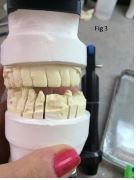Tips for Better Communication with the Lab using Your Smartphone
 Now your phone can take great digital photos for you to send to your laboratory. No longer do you need a $2000+ digital camera. Although there may be minor issues, your smartphone takes as good a photo as your expensive and heavy digital camera.
Now your phone can take great digital photos for you to send to your laboratory. No longer do you need a $2000+ digital camera. Although there may be minor issues, your smartphone takes as good a photo as your expensive and heavy digital camera.
Smartphone cameras are one of the fastest growing segments of the digital camera market. Many offer higher megapixels, higher storage capacity and better lenses.
 Lab communication can be instantaneous when you text a question and attach a photo. In addition the lab can communicate with you when we have a technical question. This saves time for everyone- no playing phone tag, holding up the case return. For example:
Lab communication can be instantaneous when you text a question and attach a photo. In addition the lab can communicate with you when we have a technical question. This saves time for everyone- no playing phone tag, holding up the case return. For example:
- If we are unsure of the margin, we can send a photo (or video) asking for clarification. (fig 1)
- We can send a photo for clarification of spacing or clearance. (fig 2)
- We can send a video of the articulation while moving the object to different angles and asking for clarification. (fig 3)

Take better photos with your smartphone:
Good Lighting (Turn off the Flash): The problem with many smartphone flashes is that they aren’t the same as a camera flash. They’re glorified LED flashlights. While they are bright, the color may be distorted. The “flash” duration is too long resulting in a blurry image.
Keep Your Lens Clean: Hazy, dark images that don’t look good can be a result of everyday grim on the lens. Use a soft cloth and give it a quick wipe. Occasionally use a lens cleaning solution. The lens may look clean but that deep clean will make a difference.
Get Close: Many smartphone cameras take better photos when you bring them in close to your subject. The small sensor provides a relatively wide depth of field allowing you to get entire objects in focus. Large cameras with bigger sensors and longer lenses have trouble. When you get close, you usually have more control over the lighting of your subject. Small detailed shots can be quite effective.
Don’t Use Zoom: Many smartphone cameras have the digital zoom function. We recommend you don’t use it. Images start to degrade as soon as you start to zoom. You will not like the result. If necessary, crop the photo because the pixel resolution remains the same. Many smartphones have 8-megapixels of resolution and sometimes more. That means you can crop substantially and still have plenty of resolution left.




